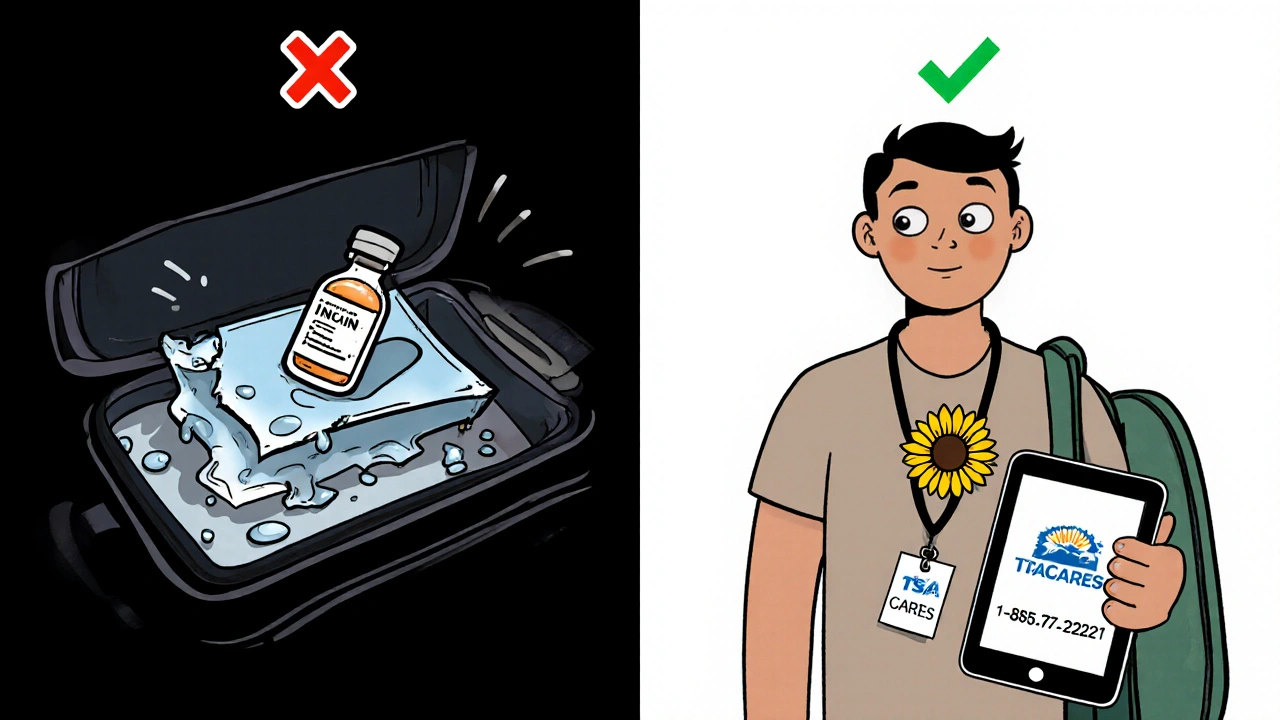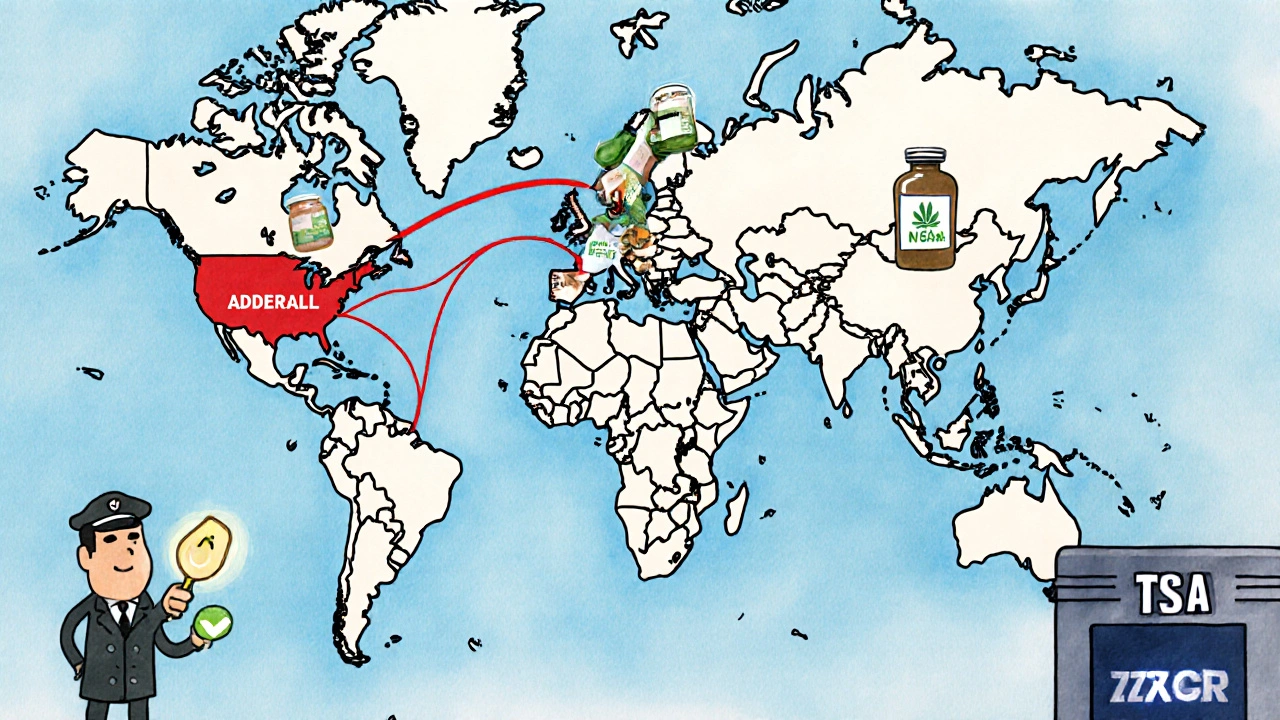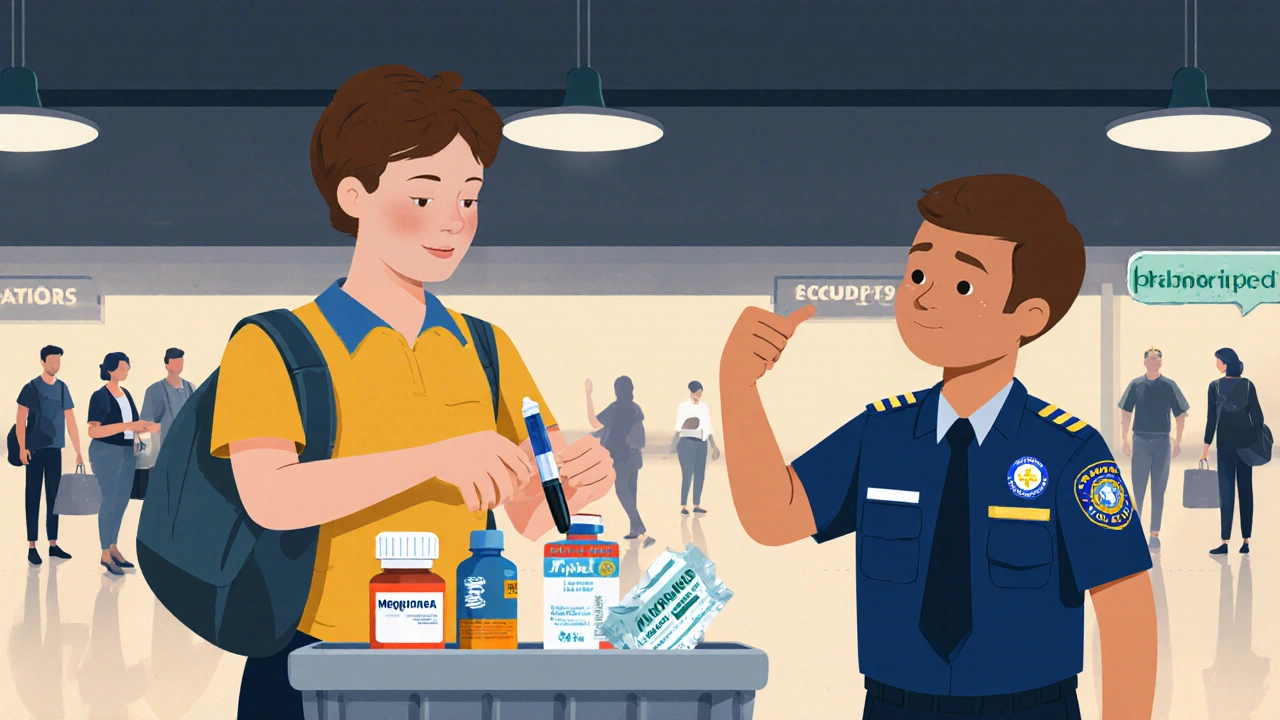When you’re flying with prescription medications, the last thing you want is to get held up at security because your insulin pen looked like a suspicious liquid or your pain cream got confiscated. The good news? The TSA lets you bring prescription medications on planes with almost no limits. The bad news? Many travelers still get confused - and sometimes even lose their meds - because they don’t know the real rules.
Prescription Medications Are Exempt from the 3-1-1 Rule
You’ve seen the signs: liquids must be 3.4 ounces or less, all in one clear quart-sized bag. But that rule doesn’t apply to your medications. Whether it’s liquid insulin, cough syrup, eye drops, or even topical creams like hydrocortisone, you can bring as much as you need. No limits. No plastic bags. No questions asked - as long as it’s FDA-approved and for personal use.
At security, you’ll need to take these items out of your carry-on and put them in a separate bin for screening. Don’t just toss them in with your shoes and laptop. Tell the TSA officer: “I have medication here.” It speeds things up. They’re trained to handle this - it’s not unusual. In fact, 12.7% of all passenger questions at checkpoints in 2024 were about meds.
You Don’t Need Original Packaging - But It Helps
TSA doesn’t require your pills to be in their original bottles. You can transfer them to a pill organizer, a travel case, or even a Ziploc bag. But here’s the catch: if your name on the bottle doesn’t match your ID, you’ll get delayed. A lot of travelers run into this problem. United Airlines found that 78% of medication-related delays in 2023 happened because of name mismatches - like “J. Smith” on the prescription and “John Smith” on the passport.
Best practice? Keep your meds in original containers if you can. If you’re short on space, at least bring a copy of your prescription or a doctor’s note. It’s not mandatory, but it’s your best defense if someone questions your meds. For controlled substances like Adderall, Xanax, or oxycodone, this becomes even more important.
Never Pack Medications in Checked Luggage
Never. Do. It.
United Airlines, Delta, American - all major U.S. carriers now explicitly say: keep all medications in your carry-on. Why? Because checked bags get lost, delayed, or damaged. And if your life-saving insulin, heart medication, or seizure drugs ends up in the cargo hold, you’re in real trouble.
There are real stories. One woman flying to Florida had her entire month’s supply of thyroid medication stolen from checked luggage. Another had her insulin freeze and break in the baggage hold. Both missed flights and ended up in urgent care. TSA and the CDC both warn against this. If you’re flying internationally, it’s even riskier - some countries will confiscate meds found in checked bags without even asking.
CBD and Marijuana Are Still a No-Go - Even If Legal in Your State
This is the biggest trap. Just because your state allows CBD oil or medical marijuana doesn’t mean the TSA lets you bring it on a plane. Federal law still bans cannabis products with more than 0.3% THC. That includes gummies, tinctures, vape pens, and even some “hemp-derived” creams.
Even if the bottle says “0.2% THC,” TSA officers have no way to test it on the spot. If it looks like marijuana, they’ll take it. In 2023, over 14,000 CBD products were confiscated by TSA - and later confirmed to be legally compliant. But by then, the traveler was already late for their flight.
Bottom line: if it’s derived from cannabis, leave it at home. The risk isn’t worth the hassle. And yes, this applies to flights leaving from the U.S., even if you’re headed to Canada or Europe.

International Travel? Check the Destination Country’s Rules
Here’s where things get dangerous. A U.S. prescription doesn’t mean anything overseas. In Japan, Adderall is illegal. In the UAE, Xanax is a felony. In South Korea, even common antidepressants like Zoloft can get you arrested.
The CDC’s 2024 Yellow Book says over 67% of countries have medication rules that differ from U.S. standards. That’s why travelers need to check before they go. The TSA app now includes a link to the IAMAT database - you can search by country and medication to see if it’s allowed. For example: “Can I bring my ADHD meds to Dubai?” → Search → “No, prohibited.”
For longer trips - over 90 days - Customs and Border Protection recommends carrying a letter from your doctor explaining why you need the medication. If you’re carrying more than a 90-day supply, you’ll need to declare it on your customs form and possibly get pre-approval.
Special Devices? Insulin Pumps, CGMs, Nebulizers
If you use an insulin pump, continuous glucose monitor (CGM), nebulizer, or other medical device, you can bring it through security. TSA allows these devices to be screened visually instead of with X-ray machines - but you have to ask.
Don’t wait until you’re at the checkpoint. If you need special help - like a private screening or extra time - call TSA Cares at 1-855-787-2227 at least 72 hours before your flight. They’ll assign you a specialist to guide you through the process.
For devices with batteries, make sure they’re charged. TSA may ask you to turn them on to prove they work. Don’t pack spare batteries in checked luggage - they must go in your carry-on.
Temperature-Sensitive Meds? Frozen Gel Packs Are Allowed
Need to keep your insulin cool? You can bring frozen gel packs through security - as long as they’re completely frozen solid. If they’re slushy or melting, TSA might not let them through.
Insulated bags are fine. Ice packs are fine. Dry ice? That’s different - you need special approval and packaging. Stick to gel packs. They’re easier, safer, and widely accepted.

What to Pack in Your Travel Medication Kit
- All prescriptions in original bottles (or with copies)
- Doctor’s note for controlled substances or injectables
- Insulin, epinephrine, or other emergency meds in your carry-on
- Extra supply (at least 3-5 days beyond your trip)
- Travel-sized pill organizer (if you use one)
- Medication list with generic and brand names
- Copy of your insurance card
- CBP declaration form (for international trips)
And here’s one thing you shouldn’t do: don’t decant your meds into unlabeled containers. The CDC says 34% of international medication issues in 2023 came from travelers using unlabeled bottles. If a border agent can’t identify what it is, they’ll confiscate it.
TSA PreCheck and Sunflower Lanyard: Faster Screening for Meds
If you’re a TSA PreCheck member, you’re in luck. Since October 2024, PreCheck travelers can keep their medications in their bags during screening. No need to pull them out. Just walk through like normal.
And if you have a hidden disability - chronic pain, anxiety, diabetes, or anything that makes security stressful - you can get a Sunflower Lanyard. It’s a discreet way to signal to TSA officers that you might need extra time or assistance. The program, originally from the UK, is now available at 45 major U.S. airports.
What’s Changing in 2025?
There’s no such thing as “2025 TSA rules” yet. Some YouTube videos claim new regulations are coming - but those are just marketing. The current rules, updated in 2023, are still in effect.
What’s actually coming? TSA is testing biometric verification for medication declarations - think facial recognition linked to your medical profile. And IATA and the WHO are working on a global standard for medical travel documents. That could mean a digital passport for your meds by late 2025. But for now, stick with the basics: keep it in your carry-on, know your limits, and double-check international rules.
Can I bring my prescription pills in a pill organizer?
Yes. TSA doesn’t require pills to be in original bottles. But make sure your name on the organizer matches your ID. Bring a copy of your prescription or doctor’s note to avoid delays.
Is CBD oil allowed on planes if it has less than 0.3% THC?
Technically yes - but in practice, no. TSA officers can’t test THC levels on the spot. If they suspect it’s marijuana, they’ll confiscate it. Even compliant products have been seized. The safest choice is to leave CBD oil at home.
Can I bring my insulin on a plane?
Absolutely. Insulin - whether in pens, vials, or pumps - is fully allowed in any quantity. You must declare it at security, but you don’t need to put it in a plastic bag. Keep it in your carry-on, never checked luggage.
What if my medication is a controlled substance?
You can bring controlled substances like Adderall, Xanax, or oxycodone, but you must have a valid prescription and matching ID. A doctor’s letter helps. International travel requires extra caution - many countries ban these drugs entirely.
Should I bring extra medication?
Yes. Always bring at least 3-5 days extra in case your flight is delayed or your luggage is lost. This is especially important for chronic conditions. The CDC recommends this for all travelers.

Melanie Taylor
November 14, 2025 AT 21:31Just brought my insulin through LAX last week - no issues! Put it in a little cooler bag, told the agent, they nodded and waved me through. So easy. Seriously, why do people stress so much? 😊